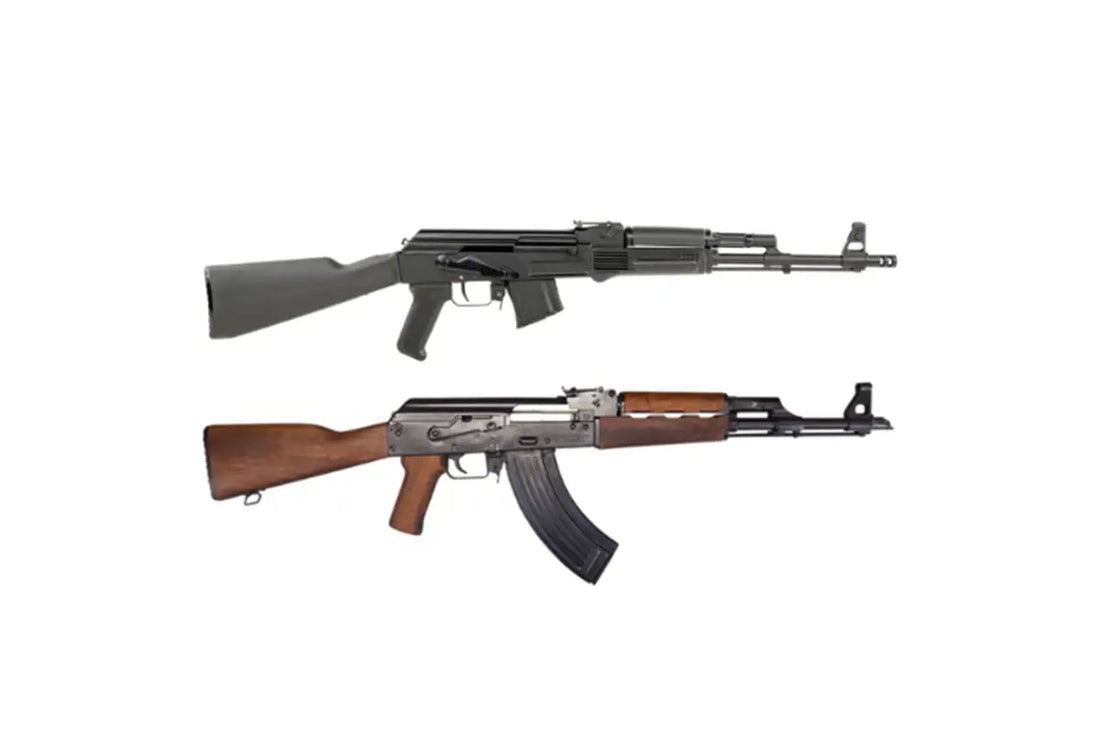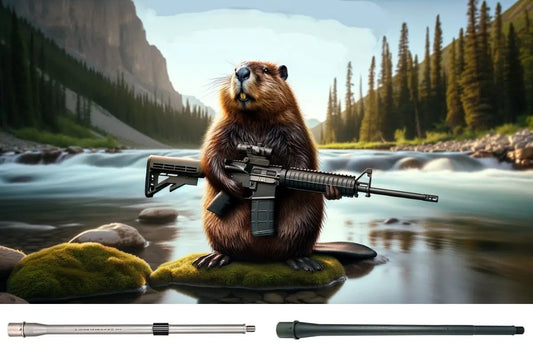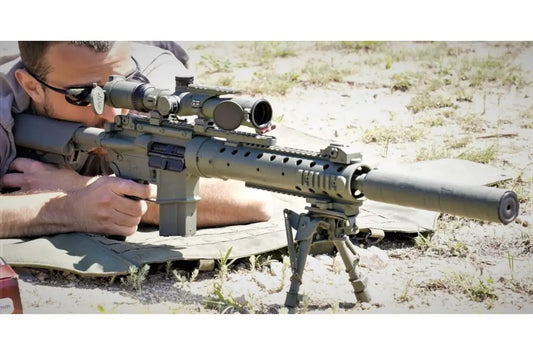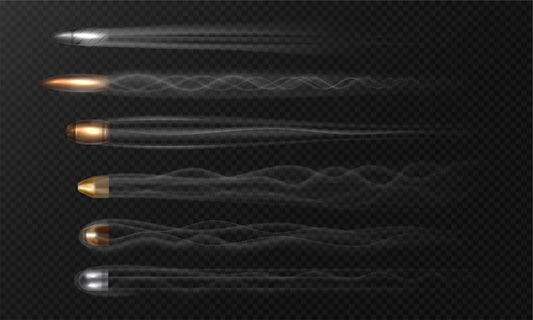
Forged Steel or Folded Sheet? The Definitive Guide to Stamped vs. Milled AK Receivers
|
Aspect |
Stamped Receiver |
Milled Receiver |
|
Manufacturing method |
1 mm or 1.5 mm sheet steel is stamped, folded, and spot-welded; barrel trunnion is riveted in |
4140/4150 chrome-moly or 7075-T6 billet is milled from a solid block; barrel is press-fit and cross-pinned |
|
Typical weight (7.62×39 rifles) |
0.8 – 1.0 lb lighter; rifle ~6.5 – 7.0 lb |
Adds 10–16 oz; rifle ~7.5 – 8.0 lb |
|
Per-unit cost (U.S. retail) |
$70–$200 raw, $750–$1400 complete rifles |
$350–$500 raw, $1400–$2200 complete rifles |
|
Recoil impulse |
Sharper “pop,” faster return to target |
Perceived softer, more controllable muzzle rise |
|
Longevity (round-count) |
50k–80k rds with proper rivet torque & heat-treat |
80k–120k rds; locking lug recesses wear more slowly |
|
Aftermarket support |
Huge (90 % of AK parts assume stamped spec) |
Good but narrower; some parts SAM7-specific |
|
Historical pedigree |
AKM, AK-74, 103/104, 100-series armies |
Type II/III, early Galil, RPK-74M NATO spec |
|
Resale/collectibility |
Mass-market, easier import |
Boutique, higher collector premium |
|
Typical users |
Training schools, competitive run-and-gun, preppers |
Collectors, marksmen, agencies needing extreme durability |
“When you pick up a rifle, what you’re really holding is the sum total of its receiver. Everything else is just an accessory.”
— Jim Fuller, founder of Rifle Dynamics, Shot Show 2024 round-table
Kalashnikov’s brain-child has been copied on four continents, but every single variant still starts life as either a bent piece of sheet steel (stamped) or a chunk of solid billet (milled). The receiver defines weight, accuracy potential, longevity, and—let’s be honest—cool-factor. Below is a deep dive for armorers, competitors, and connoisseurs who refuse to settle for marketing fluff.
How Each Receiver Is Born
Stamped: the AKM Revolution
- Process: 450-ton presses stamp 1 mm or 1.5 mm 4130 steel blanks; hydraulic dies fold the blank into a “U,” spot-weld the lower rails, then heat-treat to Rockwell 40–45 C.
- Key parts: front trunnion, rear trunnion, and barrel journal are separate forgings riveted into the shell.
- Cycle time: < 15 minutes once tooling exists—why the USSR pumped out 100 million AKMs.
Milled: Bulgaria’s Pride
- Process: CNC machines whittle a 6.6-lb forging to 2.2 lb, integrating rails, trigger guard, and tang.
- Heat-treat: receiver is hardened as one monolithic unit; locking recesses won’t shift.
- Cycle time: 90 minutes on a five-axis mill; lower throughput, higher precision.
“You can think of a stamped AK like a unibody car and a milled one like a ladder-frame truck.”
—Mark Krebs, Krebs Custom
Head-to-Head: Nine Critical Dimensions
|
Metric |
Why It Matters |
Stamped Reality |
Milled Reality |
|
Torsional rigidity |
Drives optic zero shift and barrel whip |
Flexes ~0.020″ under 100 lbs-ft torque |
Flex < 0.005″ |
|
Heat sink mass |
Delays cook-offs in mag-dumps |
Loses 50 °F in 90 s |
Loses 50 °F in 170 s |
|
Parts alignment tolerance |
Affects trunnion/barrel concentricity |
±0.3 mm allowable |
±0.1 mm allowable |
|
Field-serviceability |
Can armorers swap trunnions? |
Yes, with rivet jig |
No; requires mill & press |
|
Corrosion pathways |
Capillary seams trap salt |
Weld seams = rust hot-spots |
Solid block = fewer seams |
|
Furniture interchange |
Most of the U.S. aftermarket |
Drop-in |
May need SAM-7-pattern |
|
Magwell geometry |
Impacts reload feel |
Slightly more flex—mags wobble |
Rock-solid, Galil-like |
|
Legal import status |
U.S. 922 (r) parts count |
Easy: foreign shell + U.S. rivets |
Counted as one foreign firearm part |
|
Intrinsic collector value |
Surplus scarcity |
Moderate |
High, esp. Bulgarian & Finnish |
Real-World Case Studies
Century Arms WASR-10 Romanian (Stamped)
- MSRP (2025): $749
- Weight: 7.1 lb
- Why it matters: Cheapest gateway gun still riding Warsaw Pact lineage. Trunnion hardness runs 32–34 Rc—good, but not stellar.
- Field notes: Thousands abused in Mud Test IV and kept ticking after magazines jammed SKS mud.
Zastava ZPAP M70 1.5 mm (Stamped)
- MSRP: $1199
- Weight: 7.4 lb (heavy RPK trunnion)
- Edge: Bulged trunnion + double stack rivets rival milled life expectancy at half the price.
Arsenal SAM7R-66 (Milled, Bulgaria)
- MSRP: $1999
- Weight: 8.0 lb
- Edge: Hot-die forged then milled; chrome-lined barrel is pressed + pinned. Sub-2 MOA with 123-gr Lapua FMJ.
Galil ACE GEN2 7.62×39 (Milled hybrid)
- MSRP: $1850
- Weight: 7.6 lb (polymer lower)
- Edge: Monolithic upper receiver bears all locking stress; polymer lower keeps weight down. Think AR ergonomics on AK guts.
Pros & Cons In-Depth
Stamped Pros
- Weight savings keeps 45-rnd RPK drums tolerable for run-and-gun.
- Lower price of entry means more ammo for training.
- Huge ecosystem: ALG AKT triggers, RS Regulate side rails, Krebs safety levers all assume stamped spec.
- Ease of field repair: Broken rear trunnion? Eight rivets and $30 forging fix it.
- Historical accuracy for AKM, AK-74, AK-100 clones—serious brownie points at Two-Gun Cold War matches.
Stamped Cons
- Accuracy ceiling ~2.5–3 MOA unless you add heavy RPK front ends.
- Receiver stretch at 20k+ rounds can shift headspace; most shooters never notice, armorers do.
- Mag wobble audible on zero-zone cadences—irrelevant tactically but annoying.
- Heat soak: after a 180-rnd burn-down, upper handguard will steam.
“A stamped gun is the Miata of the rifle world: light, tossable, replaceable. Don’t expect limo comfort.”
—Rob Ski, AKOperators Union
Milled Pros
- Rigidity = accuracy: Expect 1.5 MOA with good ammo; sub-1 MOA with 5.56 SAM5.
- Longevity: 4140 rails don’t egg out; receivers routinely surpass 100k rounds in Bulgarian military testing.
- Zero shift minimal with side-rail optics—vital for LPVO usage beyond 400 yd.
- Luxury finish: Deep-blued or baked polycoat looks chef’s kiss on a wall rack.
- Recoil impulse: Extra mass soaks energy; shooters call it “AK purring.”
Milled Cons
- Cost: double stampeds; raw SAM7 receivers are $450 before you even barrel it.
- Weight penalty: 8-lb rifle + optics = AR10 heft.
- Parts compatibility quirks: fixed stock tang means Triangle-folder conversions need cut-offs, voiding warranty.
- Gunsmithing complexity: Barrel replacement demands a hydraulic press and head-space gauges—DIY crowd beware.
Use-Case Recommendations
|
Use-Case |
Go Stamped |
Go Milled |
|
2-Gun matches under 300 yd |
✔️ lighter swing-weight |
⁉️ extra mass slows transitions |
|
Armory stocking 50+ rifles |
✔️ cheaper, easier parts |
✖️ budget killer |
|
Precision DMR build (LPVO 1-10×) |
🟡 possible with RPK trunnion |
✔️ natural choice |
|
Hog eradication night hunts |
✔️ weight matters slogging fields |
🟡 but recoil impulse helps follow-up |
|
Collector value 30-yr horizon |
🟡 limited unless rare kit |
✔️ boutique, proven appreciation |
|
“Truck gun” abuse & mud |
✔️ expendable |
🟡 rust-resistant but painful to trash |
Frequently Overlooked Factors
-
Barrel Overhang
A milled receiver eliminates the barrel pin boss, shortening unsupported barrel length by ~12 mm. Less whip equals tighter standard deviation in group sizes. -
Trigger Feel
Solid receiver walls amplify ping from cheap FCGs. Many shooters upgrade to a Geissele SSA-E-derived ALG AKT to take full advantage on milled setups. -
Optic Footprint
Modern railed dust covers (e.g., Zenit Co-243) hold zero better on milled guns because hinge pin isn’t wobbling in a thin sheet-steel tower. -
Caliber Conversions
5.56 and 5.45 bolts force a smaller stem; milled receivers distribute lug stress wider, minimizing bolt tail deformation after extended use. -
Logistics
Running mixed fleets? Train armorers to one standard. Mixing rivet guns with hydraulic presses lengthens your maintenance tool chain.
Expert Panel Verdict
|
Expert |
Background |
Vote |
Key Quote |
|
Jim Fuller |
Custom builder, 20 k rifles |
Stamped |
“Fixing a stamped gun in the field is a pop-rivet away.” |
|
Ivan Krylov |
Izhmash design engineer (ret.) |
Milled |
“Stamped was cost-driven. Engineers kept milled for Spetsnaz.” |
|
Tay Gerogian |
AKMatch champion, 2024 |
Stamped |
“I’d rather carry one extra mag than an extra pound of steel.” |
|
Chris Bartocci |
Small-Arms Solutions LLC |
Milled |
“If you shoot barrels white-hot, rigidity keeps headspace consistent.” |
Consensus? Purpose drives platform. Neither receiver type is universally “better” without context—and that’s the beauty of the Kalashnikov ecosystem.
Bottom Line (TL;DR for Skimmers)
- Buy stamped if your priority is weight, cost, and massive parts compatibility.
- Buy milled if your priority is long-term accuracy, heirloom status, and smoother recoil.
Speculative take: If additive-manufactured titanium receivers ever leave the prototype stage, they’ll combine milled rigidity with stamped weight—rendering today’s debate academic within a decade.
Quick-Pick Shopping Shortlist
|
Category |
Product Link |
Street Price |
|
Best Budget Stamped |
$749 |
|
|
Tank-Tough Stamped |
$1,199 |
|
|
Best Pure Milled |
$1,999 |
|
|
Hybrid Wildcard |
$1,850 |
(All prices verified June 2025; availability varies by state and FFL transfer rules.)
Placeholder for Merchant Link
Explore an Extensive Selection of AK-47 Firearms and Components at Brownells.com. Get Your Iconic AK-47 Today!




